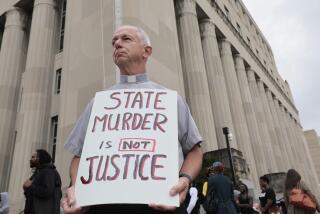One Error Out of 280 Is Not Bad, Unless You’re an Undiscovered Randall Adams
Last week a Texas appeals court set aside the murder conviction of Randall Adams, a man convicted in 1976 of killing a Dallas police officer. After spending 12 years behind bars proclaiming his innocence, it now appears that Adams was indeed railroaded by the criminal justice system.
Adams owes his chance for a new trial to a documentary film, “The Thin Blue Line.” The filmmaker, Errol Morris, stumbled upon Adams’ story while making a movie about James Grigeon, the Texas psychiatrist known as “Doctor Death” because of his remarkable ability to persuade jurors that a defendant is sufficiently dangerous to merit execution.
Unusual as it is, the case of Randall Adams is not a fluke. According to a recent study by Hugo Bedau and Michael Rodelet, 350 people this century have been wrongly convicted of offenses punishable by death, and 25 were actually executed. Since 1900, more than 7,000 people have been executed in America. The 25 innocent people put to death represent only 1 out of 280, an excellent record if we are talking about stopping drivers for exceeding the speed limit. But is it accepable when the mistake means that an innocent person will be executed? Before you are tempted to answer yes, it might be helpful to know that of the more than 1,600 men and women currently on death row, it is a statistical certainty that four or five of them are innocent.
Regardless of one’s position on the death penalty, the Randall Adams case is deeply disturbing--not merely because an innocent man was almost executed, but because the trial judge and Texas authorities behaved in a way that violated Adams’ constitutional right to a fair trial. At the original trial, the judge improperly restricted testimony about the criminal record of another man who has since all but confessed to the killing. The authorities improperly suppressed police reports and knowingly used perjured testimony. What’s more, Adams was not adequately represented by counsel.
We all know that no system of justice is perfect. We also know that there is no way of administering the death penalty without making errors. Perhaps we could better accept a few innocent people being executed if their convictions were merely accidental--the result of good-faith efforts yielding mistaken outcomes. But this is not always the case. Adams, and many other people in similar predicaments, got there because either police, prosecutors, defense attorneys, judges, witnesses and even jurors conspired to sentence them to death. Others ended up on death row because the authorities neglected to see that they received a fair, competent and impartial trial. Only some of the mistakes in capital cases are the result of well-intentioned errors and human accidents.
Many Americans who support the death penalty feel outraged when a convicted murderer evades the gallows or, more accurately, the gas chamber or the electric chair. But too few feel that same strong emotion when an innocent man is almost put to death. The problem of executing innocent people is not a pro- or anti-capital punishment issue, although it often breaks down along those lines. It is a problem of human fallibility and malfeasance, neither of which can be effectively remedied. The “super due process” requirement that the Supreme Court has put in place during the past 15 years has made the administration of the death penalty cumbersome and costly, with appeals sometimes drawn out more than 10 years. Unfortunately, as Adams’ case reveals, even such extraordinary constitutional protections cannot ensure that only the guilty will be sentenced to death.
Some might argue that the system worked in the case of Randall Adams. After all, Adams was not executed. He will probably go free. But Adams was vindicated in spite of the system, not because of it. Randy Schaffer, Adams’ lawyer, had been trying to get the case reopened since 1982, to no avail. The national publicity generated by “The Thin Blue Line” forced the authorities in Texas to act.
The Bedau/Rodelet research indicates that the three most important factors in discovering a miscarriage of justice are: when the actual perpetrator confesses; through the persistent and often unpaid efforts of dedicated defense counsel; or through publicity generated by a journalist or author. Randall Adams had all three. He also had the benefit of a Supreme Court decision that commuted his death sentence to life imprisonment because of the way his jury was selected. Otherwise he would have been executed. No film about his case would ever have been made. And he would have gone to his death--just another guilty convict proclaiming his innocence.


